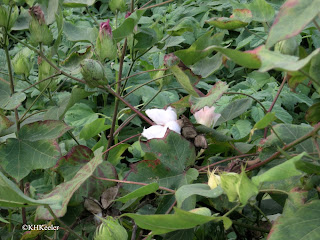So today, a quiz:
I don't have the right pictures, so I send you to the web to see pictures of the plants.
Where are the following plants native?
Boston ivy, Parthanocissus tricuspidata Boston ivy
Egyptian cotton, Gossypium barbadense Egyptian cotton
Jerusalem artichokes, Helianthus tuberosus Jerusalem artichokes and the flowering Jerusalem artichoke
Russian sunflowers, Helianthus annuus Russian sunflowers
And the answers are:
Boston ivy, Parthenocissus tricuspidata is from Asia. Introduced to the West from Japan in 1869, it was soon widely planted in US. Alternate names for it include Japanese creeper and grape ivy (it is related to grapes, same plant family,Vitaceae). However, it is best known because it is grown all over walls in Boston, Massachusetts, including at Fenway Park. Consequently it is called Boston ivy. In its native China, P. tricuspidata is called pashanhu, mountain-climbing tiger.
 |
| Egyptian cotton |
The Jerusalem artichoke isn't from Jerusalem or an artichoke. It is a sunflower, Helianthus tuberosus and native to central North America. Apparently the name Jerusalem is a mispronunciation of the Italian word for sunflower, girasole. The edible "artichoke" is a tuber from the roots, not much like an artichoke, which is a flower bud. (Jerusalem artichoke picture).
 |
| Russian sunflowers |
Comments and corrections welcome.
References
Heiser, C.B., Jr. 1995. Sunflowers, Helianthus (Compositae). pp. 51-53 in J. Smartt and N. W. Simmonds, eds. The Evolution of Crop Plants. Longman Press, London.
Mabberley, D.J. 1997. The Plant-Book. 2nd. ed. Cambridge University Press, Cambridge.
Valder, P. 1999. The Garden Plants of China. Timber Press, Portland, OR.
Links updated 1/30/21.
Kathy Keeler, A Wandering Botanist
Kathy Keeler, A Wandering Botanist
More at awanderingbotanist.com
Join me on Facebook
No comments:
Post a Comment